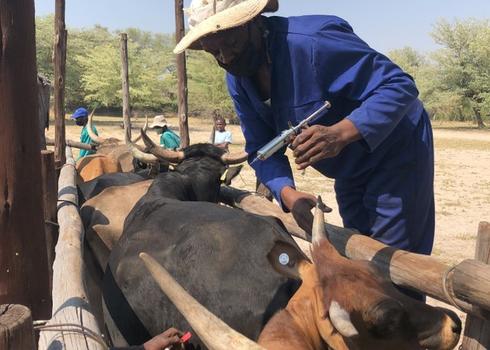
Conrad Lifatila, a small-scale livestock farmer in the Zambezi region of Namibia, never thought that his cattle would survive to see this day after the dreadful foot and mouth disease (FMD) engulfed the area. His cattle were getting thinner by the day as grazing became an almost impossible task due to the inflammation and sores in their mouths and on their feet.
“I thought they would all die because they were in such a terrible state, which gave me sleepless nights,” said Conrad. Desperate for ways to try to save his cattle, Conrad resorted to using a homemade remedy of bicarbonate of soda solution to wash the infected lesions on his cattle. Farmers believe bicarbonate of soda has anti-inflammatory and antiseptic properties which aids in wound healing.
The local State Veterinary Office (SVO) and its staff swiftly moved into action during the peak of the FMD outbreak in the region working hard to normalize the situation. “Once we detected the outbreak, all hands were immediately on deck to contain the spread of this disease, which causes lameness, reduced milk production, and some mortalities in cattle,” said Michael Tiyeho, a State Veterinarian based in the region.
Michael attributes the improved detection and response to the FMD outbreaks in the region to the capacity development of veterinarians operating in the Northern Communal Areas, a high-risk zone for transboundary animal diseases.
“Through the STOSAR project, we have received extensive training on surveillance and monitoring of transboundary animal diseases such as FMD, which has equipped us with the knowledge and skills to better respond and handle these outbreaks,” he said “Our testing capacity has greatly improved. We were quick to identify the new FMD strain and contain its spread with the right vaccine,” he said.
The new FMD strain is the ‘O’ serotype that causes high infection rates amongst livestock in the region and can affect pigs and dairy cattle. The strain is believed to have originated from a neighbouring country as a result of the illegal movement of cattle by communities living along the borders of the two countries in search of good grazing.
“The STOSAR project has made a difference in the management of transboundary animal diseases in our region, and we are very grateful for the support,” Michael concluded.Through this intervention, Conrad’s herd of cattle received timely FMD treatment and have since fully recovered from the disease. The animals are now thriving. “Thanks to the STOSAR project, my livestock, which is my source of livelihood, did not succumb to the FMD outbreak and I was fortunate not to lose any animals. My herd of cattle is now flourishing,” he added with a smile

